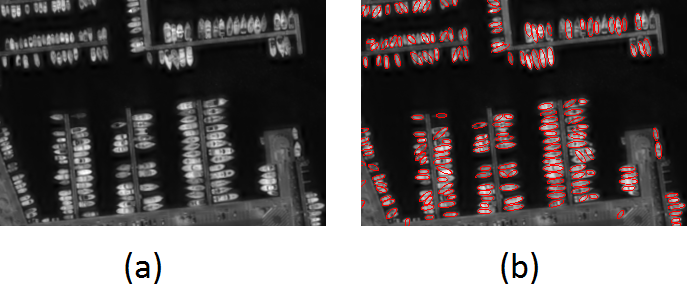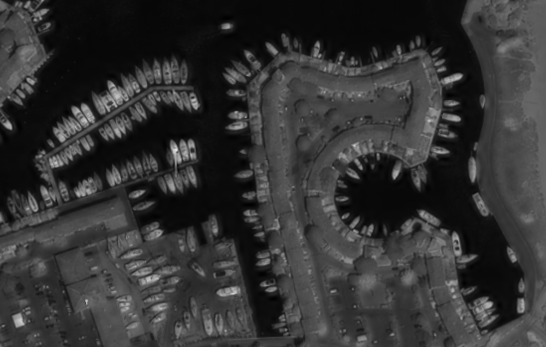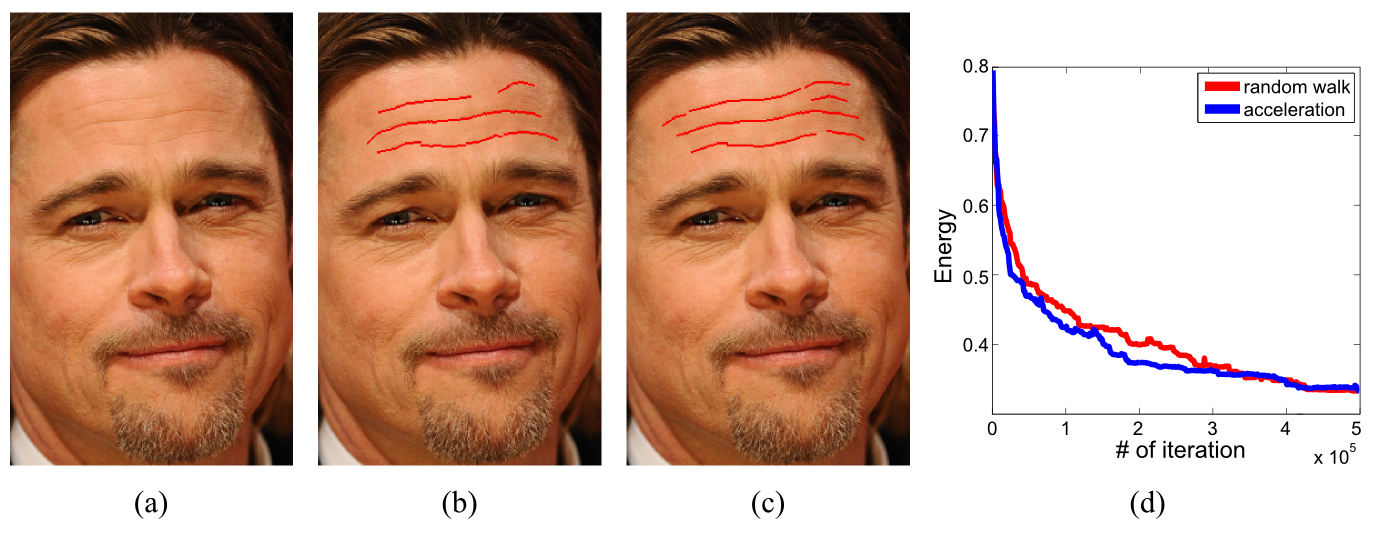Section: New Results
Marked point processes
Marked point process models for boat extraction from high resolution remotely sensed optical images
Participants : Paula Craciun, Josiane Zerubia [contact] .
This work was done in collaboration with Dr. Mathias Ortner (ASTRIUM EADS) [http://www.astrium.eads.net ] and Prof. Pierre del Moral (ALEA team, Inria Bordeaux).
Stochastic geometry, Markov model, detection, parallel algorithm
Marked point process models have been successfully applied to object extraction problems in high resolution optical images, ranging from tree crown or road extraction to flamingo or crowd counting. We try to model the problem of boat detection and counting in harbors. The difficulty of this problem resides in the particular distribution of the objects. The model consists of two energy terms: a data term, which reflects the model's fidelity to the input image, and a prior term containing knowledge about the objects to be extracted. The model relies on a high number of parameters and is computationally intensive. The purpose of this research is to extend a previously developed marked point process model of ellipses and make it more computationally manageable. In particular, we add a preprocessing step in which we determine the global and local direction of the objects [8] , [17] . Additionally, segmentation of land and water areas is implemented as a preprocessing step. Boat extraction results are shown in Figure 4 . Finally, we implement an improved parallel sampler, thereby drastically improving computation times.
|
Parameter estimation for automatic object detection in very high resolution optical images
Participants : Aurélie Boisbunon, Josiane Zerubia [contact] .
This work was partially funded by the French Space Agency CNES [http://www.cnes.fr ].
Markov model, Monte Carlo method, evolutionary algorithm, optimization, image processing, detection
The main goal of this work is to study parameter estimation for several marked point processes. Currently, the parameters of such models are estimated by a Stochastic Expectation and Minimization (SEM) algorithm, which is computationally expensive. We will investigate and propose new parameter estimation techniques, based on Randomized Quasi-Likelihood and evolutionary algorithms, for the parameters of the probability density of a marked point process. The goal is to improve computation times with respect to SEM while maintaining similar accuracy. The first application envisioned is boat detection for harbor activity monitoring (see Figure 5 ).
Wrinkle detection using a marked point process
Participants : Seong-Gyun Jeong, Yuliya Tarabalka, Josiane Zerubia [contact] .
Skin image processing, wrinkle detection, line detection, marked point process, RJMCMC
We developed a novel wrinkle detection algorithm using a marked point process (MPP). Since wrinkles are the most important visual features of aging, automatic wrinkle detection algorithm can have many applications, such as the evaluation of cosmetic products, age estimation, and aging synthesis. In order to detect wrinkles of arbitrary shape, we represent wrinkles as a set of small line segments. Note that each line segment consists of a length and an orientation. A stochastic wrinkle model density exploits the local edge profile and constrains the spatial placement of adjacent lines. To maximize the model density, we employ a reversible jump Markov chain Monte Carlo (RJMCMC) sampler. A state of the Markov chain corresponds to a wrinkle configuration, and it is updated according to the acceptance ratio of sub-transition kernels: line segment births and deaths, and an affine transformation kernel. The transition kernels perturb the Markov chain by adding, removing, or modifying a wrinkle segment in the current configuration. In addition, an acceleration scheme has been developed for the RJMCMC sampler that enforces the connectivity of line segments. RJMCMC with acceleration reduces mixing time and improves detection accuracy as well.
Figure 6 compares wrinkle detection results simulated by random walk and the proposed acceleration scheme. The proposed algorithm faithfully detects wrinkles as smoothly connected lines. In addition, Figure 6 (d) plots the energy as a function of the number of iterations. It shows that the proposed acceleration method reaches a lower energy more rapidly than the random walk method.




